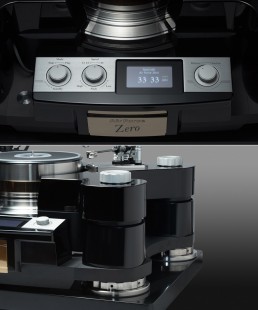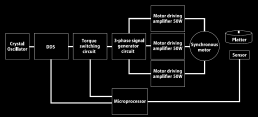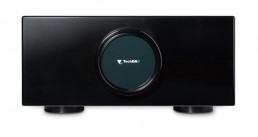Our Path to the Air Force Zero
In recent years we have seen hundreds of analog turntables released, and this has been a major trend in the audio industry. What does this phenomenon mean?
One of the major reasons is a backlash from the excessive transition from analog to digital audio. Around this time of transition to digital, there was already a serious demand for high quality analog decks from some discerning audiophiles. It was clear to us something was missing in the digital domain that audiophiles were desperately seeking.
With this growing trend in the market, in 2008 we started research and development of authentic analog turntables. Striving toward a goal of developing a turntable delivering the highest performance of the present day, and in a practical sized chassis, we finally launched our first analog turntable, the Air Force One in 2012. This product proved to be hugely successful, a turning point in analogue reproduction, and spread out to far more users across the world than we first imagined. Since then we have continued development and launched an extensive line of turntables to meet more demands in the market. Currently we have a full product range from the Air Force One Premium, Air Force Two Premium, Air Force III Premium to the Air Force V.
In parallel to the development and releases of these models, a project was going on at TechDAS to bring our dream of the absolute ultimate reference turntable to reality. The goal of the project was to develop a truly groundbreaking product, building on our expertise and knowledge and incorporating new ideas and insights. To achieve this goal, the project had to be cost-no-object. And it had to have whatever technologies would be best suited for sonic performance, no matter how much it would cost. We are pleased to announce it is finally complete, though it took one year longer than initially planned. The result is a turntable weighing 330 kg and measuring 902 (W) X 677 (D) X 335 (H) mm.
The Design Process
Unlike the Air Force One, which we developed with a few conditions to meet, we set no limitations in designing the Zero. However, at the beginning of this project, we had a few guidelines we used in the design process as listed below:
1. The size of the entire system to be up to that of the classic EMT927 ( In fact the size is larger as it turns out)
2. The weight of each component to be kept within the limit our suppliers could handle in processing.
3. To be fitted with both 10 inch and 12 inch tonearms.
4. To develop a platter as large as 40 cm in diameter.
Most exceptionally, the main system weighs 330 kg. It is actually much more than we initially expected. This is an absolutely colossal system.
Technical features of the Air Force Zero Motor
The first task was to find a motor to drive this gigantic system. By pursuing every avenue, we finally found some high quality synchronous motors manufactured for tape recorders by the renowned German manufacturer, Papst. These motors proved to be most suitable for our aim, which opened the door to the success of the Air Force Zero project.
The next step was to review and modify the Papst motors so that they could work optimally for the world’s best turntable system. Building on the 3-phase, 12-pole synchronous AC large torque motor, we developed a customized air bearing and flywheel technologies which we used in driving the motor.
The major features of the Air Force Zero Motor are:
1. High precision rotation with virtually zero wobble due to the combination of high precision metal bearing and air bearing.
2. Enormous inertia generated by flywheel effect.
3. Extremely high S/N ratio achieved by the air bearing.
4. New electronic driving circuitry designed for stable and precise rotation with low vibration.
During a steady state rotation, the driving amplifiers perform smooth rotation without the servo. The servo will be engaged only during the startup process or if the speed is changed by an external force. These technologies results in an exceptional level of rotational precision for a belt-drive turntable.
Driving System
1. Crystal Oscillator
Reference clock oscillator that provides a clock signal to stabilize rotation frequencies for the motor.
2. Direct Digital Synthesizer (DDS)
This functions as a synthesizer to divide the input clock signal according to the values of frequencies determined by the microprocessor, converting high frequencies to low frequencies so that they will work with the motor. Almost any value of frequencies can be output and precise control of the rotation is possible.
3. Torque Switching Circuit
This circuit switches the voltage to the motor in order to quickly increase the rotation torque to a rated speed during a startup or when shifting the rotational speed of the platter. When a rated speed is achieved and the rotation speed is locked, the torque will then be decreased in order to reduce vibrations even further.
4. 3-phase Signal Generator Circuit
This circuit creates an accurate phase shift to the input signal of 120 degrees to generate 3-phase AC output for the 3-phase motor.
5. Motor Driving Amplifiers
There are three 50W power amplifiers for the respective three phases, with ample current to optimally drive the synchronous motor.
6. Synchronous Motor
The motor is a 3 phase AC motor operating in synchronization with an accurate 3 phase frequency, generated with the 3 phase signal generator circuit. A more common power system for the motors has AC power phase shifted with capacitors. In the latter case, it is very difficult to provide an AC signal output with accurate phase shift due to ageing and errors in the capacitors etc. Such issues can lead to a decrease in torque and an increase in vibration.
7. Sensor
This detects the speed of the platter and transmits the information to the microprocessor.
8. Microprocessor
This controls the motor driving mechanism so that an extremely high precision rotation will be achieved.
Control Mechanism for Motor Rotation
By using a specific rotation speed for the motor stored in advance, the DDS sets a corresponding frequency value and the motor performs a high torque rotation at this stage. The microprocessor computes the difference between the rotating speed detected by the sensor and the target speed.It then transmits a speed control signal to the DDS, which in turn controls the rotation to achieve the target speed.
The indication of “LOCK” blinks on the display during this process. Once an accurate rotation of the platter is reached, “LOCK” displays permanently on the display. At the same time, the microprocessor sends a command to apply low torque and deactivate the DDS while monitoring the rotation. This is because not much extra force beyond inertia is required for a steady rotation. If the rotation speed is changed for any reason, “LOCK” will blink on the display and the microprocessor will use the DDS to correct the speed. Once the accurate speed is achieved, “LOCK” will display permanently on the display and the rotation is kept in a stead state without the need to control the speed.
The Platters & Chassis design
Platter Base
The Platter Base (35 kg, extra super duralumin) serves as a hub for the air suspension system. This Platter Base has four massive blocks composing the air suspension system mounted on it, and where two tonearms can be fitted. The Platters are made of different alloys and placed on the Platter Base. The air suspension system successfully eliminates vibrations that could transmit from the Platter Base to the tonearm and record surface by having the center of gravity much lower than the supporting point. This concept was key to our design, opposed to a theory that weight acts solely as a barometer to record players as some people believe.
Base Frame
The Platter Base sits on a 100 kg Base Frame made of SUS stainless steel. This Base Frame, which has an enhanced speed of oscillatory convergence with special surface treatment, supports the total weight of 230kg of the Platters, Air Suspension System and Platter Base.
Tonearm Bases
Two titanium tonearm bases are provided. Almost any 9 inch, 10 inch or 12 inch tonearms can be fitted with the exception of non-standard lengths.
Platters
The Platters are designed for the highest level of vibration absorption by combining different alloys. For example, the top layer is made of titanium with surface hardening treatment applied to produce hardness equivalent to hard metal alloy. More importantly, these five layers of platters are held as one with air suction similar to vacuum LP hold-down. This solution allows to us to avoid metal fittings which could induce mechanical stress.
Air Bearing
The five platters float to the height of 10µm and rotate in absolute silence as one unit. To make this possible, the Platter Base surface is precision machined with a tolerance of less than Sµm at its circumference.
Air Suspension System
The AF Zero has an Air Suspension System consisting of four blocks providing insulation and absorbing low frequency vibrations at the four corners. This air suspension module is uniquely developed by TechDAS and air is supplied from an electric pump to the air suspension modules.
The Air System & optional Rack
Power Supply/Air Pump Units
The system comes with three Power Supply / Air Pump Units of the same dimensions.
Unit 1/3: contains an Air pump for floating the platter, driving main power circuitry, and air condensers.
Unit 2/3: contains an Air pump for floating of the rotor and flywheel of the motor, 3 driving amplifiers, and sub power circuitry.
Unit 3/3: contains an Air pump for vacuum disc hold-down, air pump for air suspension, and sub power circuity.
Air Force Zero Rack (optional)
This Air Force Zero Rack system is exclusively developed and manufactured to deliver the best sound quality and performance of the Air Force Zero. It is made by Artesania Audio, a Spain-based high end rack company renowned across the world.
The system consists of two racks:
Rack 1/2: for Main Turntable, 1× Power Supply Unit.
Rack 2/2: for 2 × Power Supply Unit and phono equalizer amplifier (not included in the Air Force Zero system).
| MAIN BODY | |
| Base Frame | 100 kg, stainless steel |
| Platter Base | 35 kg, extra super duralumin |
| Platters | 100 kg in total |
| Bottom platter | 33 kg, Ø 40cm, forged Stainless Steel SUS 316L |
| Second platter | 20 kg, Ø 31 cm, forged Stainless Steel SUS 316L |
| Third platter | 20 kg, Ø 31 cm, cast Gunmetal |
| Fourth Platter | 20 kg, Ø 31 cm, forged Stainless Steel SUS 316L |
| Top Platter | 7 kg, Ø 31 cm, Titanium with special surface hardening treatment |
| Total moment of inertia | 16,000 kg/cm2 |
| Drive system | Belt-drive, polished and non flexible polyurethane fiber belt |
| Drive Motor | Drive Motor: 3-phase 12-pole AC synchronous motor manufactured by Papst, Germany (1000/5001) During a startup and adjustment of the rotation, high torque rotation In a stead-state rotation, non servo, low torque, ultra low vibration |
| Rotation speed | 33 1/3 rpm / 45 rpm, precise speed adjustment function |
| Wow & Flutter | below 0.03% |
| Suspension | Air suspension, air charged by an electric air pump with built-in Power Supply Unit |
| Main Unit Dimensions including Motor | 902 (W) x 677 (D) x 335 (H) mm |
| Distances between center point of base frame feet | front left foot – front right foot 67 4mm / rear left foot – rear right foot 722mm front left foot – rear left foot 461 mm / front right foot – rear right foot 441 mm |
| Total weight of Main Unit including Motor | 330kg (Power Supply / Air Pump Units are not included) |
| POWER SUPPLY & AIR PUMP UNITS | |
| Unit 1/3 | 430 (W) x 365 (D) x 205 (H) mm, 15 kg |
| Unit 2/3 | 430 (W) x 365 (D) x 205 (H) mm, 13kg |
| Unit 3/3 | 430 (W) x 365 (D) x 205 (H) mm, 10kg |
| ACCESSORIES INCLUDED | OPTIONAL ITEMS |
| 2 x Titanium Tonearm Bases. 1 x TechDAS Disc Stabilizer. 1 x Platter Cover. |
Tungsten top platter: 26kg, Ø 31 cm. Tungsten Disc Stabilizer. Air Force Zero RACK SYSTEM (Set of 2 racks with turntable platform and shelves). |

“From the first record Mr. Nishikawa played to the final record I played, the crowd was treated to what all in attendance agree was the finest vinyl playback any of us have ever heard and it wasn’t even close. This turntable stomped all over every other turntable I’ve ever heard…It wasn’t even close beginning with blacker backgrounds than I’ve ever heard from a turntable. It was so quiet that I often worried that the system was in “mute” when suddenly the music poured forth at high SPLs from the speakers.”
“The system’s effortlessness was revelatory. Familiar records like Masterpieces by Ellington revealed heretofore hidden textural and tonal nuances, helping to produce a “you are there” experience that thrilled on both evenings all in attendance.”
Michael Fremer
www.analogplanet.com

“The sound – oh,the sound – that the Zero produced in this setup was truly captivating. The noise floor depths were subterranean and the octave-to-octave balance seamless. It was immediately apparent to me that the TechDAS Zero was delivering a fundamentally different approach to vinyl playback. Never have I heard such 3-D presentation of musical notes.”
“Another notable moment came when Mr. Nishikawa played a Louis Armstrong LP. The pitch definition was so exact that it was something of a revelation for me to listen to Armstrong’s trumpet solo: There was a density to the burnished sound that I had not previously experienced. An audio component as technologically complex as this one (not to mention priced in the stratosphere) should smash the sonic sound barrier. That doesn’t always happen, but this time it has.”
Jacob Heilbrunn
www.theabsolutesound.com


